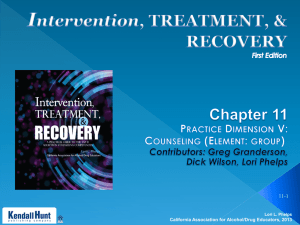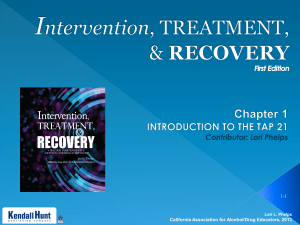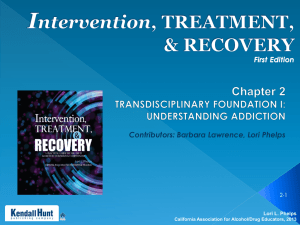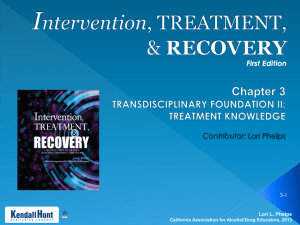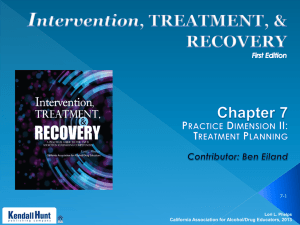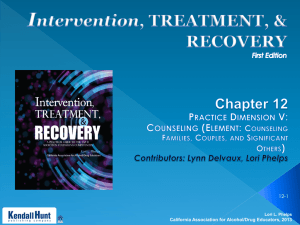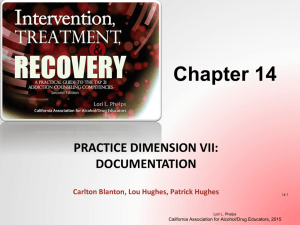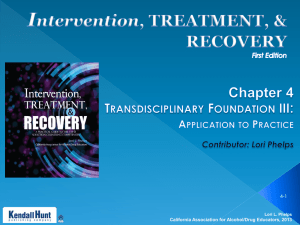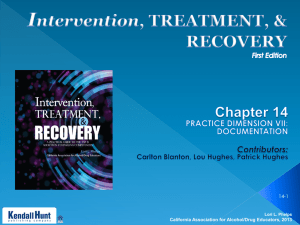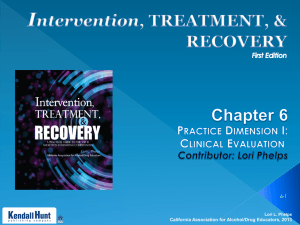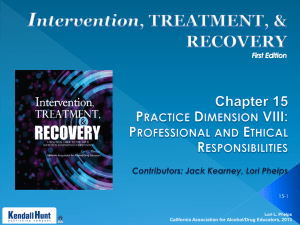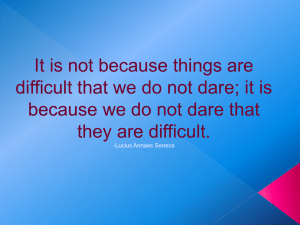Chapter 13 pptx - California Association for Alcohol/Drug Educators
advertisement
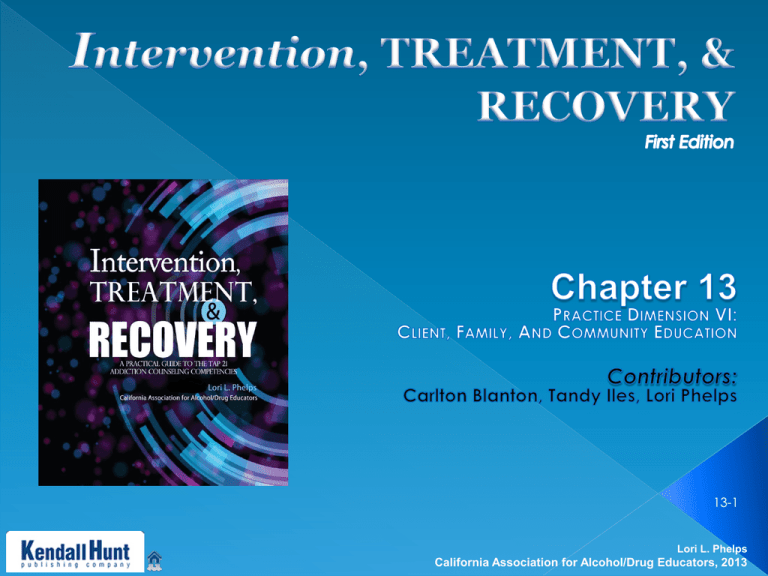
13-1 Lori L. Phelps California Association for Alcohol/Drug Educators, 2013 Client, family, and community education is defined as “the process of providing clients, families, significant others, and community groups with information on risks related to psychoactive substance use, as well as available prevention, treatment, and recovery resources.” (CSAT, 2006c, p. 123) 13-2 Lori L. Phelps California Association for Alcohol/Drug Educators, 2013 The Addictions Counselor Should: 99. Provide culturally relevant formal and informal education programs that raise awareness and support substance abuse prevention and the recovery process. 100. Describe factors that increase the likelihood for an individual, community, or group to be at risk for or resilient to psychoactive substance use disorders. 101. Sensitize others to issues of cultural identity, ethnic background, age, and gender in prevention, treatment, and recovery. 102. Describe warning signs, symptoms, and the course of substance use disorders. 13-3 Lori L. Phelps California Association for Alcohol/Drug Educators, 2013 103. Describe how substance use disorders affect families and concerned others. 104. Describe the continuum of care and resources available to the family and concerned others. 105. Describe the principles and philosophy of prevention, treatment, and recovery. 106. Understand and describe the health and behavior problems related to substance use, including transmission and prevention of HIV/AIDS, tuberculosis, sexually transmitted diseases, hepatitis C, and other infectious diseases. 107. Teach life skills including but not limited to stress management, relaxation, communication, assertiveness, and refusal skills. 13-3 Lori L. Phelps California Association for Alcohol/Drug Educators, 2013 Outcome studies suggest that tailoring services to the specific needs of cultural and ethnic groups improves outcomes Meeting the needs of diverse clients involves two components: › (1) understanding how to work with persons from different cultures, and › (2) understanding the specific culture of the person being served . Cultural competence means being a responsible, caring clinician who treats clients with respect, expresses genuine interest in clients as individuals, keeps an open mind, asks questions of clients and other providers, and is willing to learn. 13-5 Lori L. Phelps California Association for Alcohol/Drug Educators, 2013 13-6 Lori L. Phelps California Association for Alcohol/Drug Educators, 2013 Vulnerability to addiction is 40-60% genetic Community Environment (unemployment, inadequate housing, crime, drug use Minority Status (discrimination, level of assimilation, language barriers, low education levels Family (parental addiction, abuse, mental illness), stress, unemployment, violence Early behavior problems Adolescence: negative behavior/experiences 13-7 Lori L. Phelps California Association for Alcohol/Drug Educators, 2013 Community (low unemployment, adequate housing, low crime) Family (adequate income, structure and nurturing, attention during first year of life) Constitutional Strengths (intelligence, physically robust, no impairments) Personality (easy temperament, adaptable, positive, healthy expectations, self-discipline, problem-solving skills) 13-8 Lori L. Phelps California Association for Alcohol/Drug Educators, 2013 Insight - asking tough questions and giving honest answers. Independence - distancing emotionally and physically from the sources of trouble in one's life. Relationships - making fulfilling connections to other people. Initiative - taking charge of problems. Creativity - using imagination and expressing oneself in art forms. Humor - finding the comic in the tragic. Morality - acting on the basis of an informed conscience. 13-9 Lori L. Phelps California Association for Alcohol/Drug Educators, 2013 Competency 101: Sensitize others to issues of cultural identity, ethnic background, age, and gender in prevention, treatment, and recovery. Hispanics/Latinos African Americans Native Americans Asian Americans and Pacific Islanders Persons with HIV/AIDS Lesbian, Gay, Bisexual, and Transgender (LGBT) Clients Persons with Physical and Cognitive Disabilities Rural Populations Homeless Populations Older Adults 13-10 Lori L. Phelps California Association for Alcohol/Drug Educators, 2013 Adolescence is a critical time › Early use of drugs increases the chance for more serious drug abuse and addiction › Drugs change the brain Science-validated Programs › can significantly reduce early use of tobacco, alcohol and illicit drugs Universal programs address risk and protective factors common to all children in a given setting, such as a school or community. Selective programs target groups of children and teens who have factors that further increase their risk of drug abuse. Indicated programs are designed for youth who have 13-11 already begun abusing drugs. Lori L. Phelps California Association for Alcohol/Drug Educators, 2013 Mental and substance use disorders are among the top conditions for disability, burden of disease, and cost to families, employers, and publicly funded health systems By 2020, mental and substance use disorders will surpass all physical diseases as a major cause of disability worldwide. 13-12 Lori L. Phelps California Association for Alcohol/Drug Educators, 2013 Monitoring the Future Survey http://www.drugabuse.gov/DrugPages/MTF.html National Survey on Drug Use and Health http://oas.samhsa.gov/nsduh.htm 13-13 Lori L. Phelps California Association for Alcohol/Drug Educators, 2013 Practitioner Guides and Handouts http://store.samhsa.gov/product/Illness-Management-andRecovery-Evidence-Based-Practices-EBP-KIT/SMA09-4463 IMR curriculum › Recovery strategies › Practical facts about mental illnesses › Stress-Vulnerability Model and treatment strategies › Building social support 13-14 Lori L. Phelps California Association for Alcohol/Drug Educators, 2013 › Using medication effectively › Drug and alcohol use › Reducing relapses › Coping with stress › Coping with problems and persistent symptoms › Getting your needs met by the mental health system 13-15 Lori L. Phelps California Association for Alcohol/Drug Educators, 2013 Central Center for the Application of Prevention Technologies (CAPT). http://www.ccapt.org/ SAMHSA’s National Registry of EvidenceBased Programs and Practices. http://nrepp.samhsa.gov/ NIDA for teens: The science behind drug abuse. http://teens.drugabuse.gov/ Project Resilience www.projectresilience.com 13-16 Lori L. Phelps California Association for Alcohol/Drug Educators, 2013 Prevention and Early Intervention for Substance Use and Mental Disorders: What’s Working, What’s Needed? http://www.recoverymonth.gov/ResourcesCatalog/2011/Webcast/04-Prevention-and-EarlyIntervention.aspx Survivor’s Pride: An Introduction to Resiliency http://projectresilience.com/spvideo.htm Youth and College Drinking: Breaking the Patterns http://store.samhsa.gov/product/Youth-and College-Drinking-Breaking-the-Patterns/DVD253 13-17 Lori L. Phelps California Association for Alcohol/Drug Educators, 2013 What are some reasons that you use substances (or have used them in the past)? Prevention Program Research Project Reframe Your Own Life › make a summary statement that includes the powerful abilities you have developed from adversity—a statement of your survivor’s pride. 13-18 Lori L. Phelps California Association for Alcohol/Drug Educators, 2013
